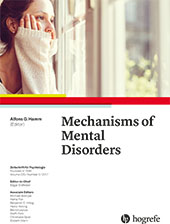Misunderstanding RDoC
Abstract
Abstract. Mental illness is fundamentally mental, by definition about psychological rather than biological phenomena, but biological phenomena play key roles in understanding, preventing, and treating mental illness. The Research Domain Criteria (RDoC) initiative of the US National Institute of Mental Health (NIMH) is an unusually ambitious effort to foster integration of psychological and biological science in the service of psychopathology research. Some key features and common misunderstandings of RDoC are discussed here.
References
(2017).
Developmental psychopathology and the Diagnostic and Statistical Manual of Mental Disorders . In T. P. BeauchaineS. P. HinshawEds., Child and adolescent psychopathology (3rd ed., pp. 33–67). Hoboken, NJ: Wiley.(2013). Classification and psychopathology research. Journal of Abnormal Psychology, 122, 894–901. https://doi.org/10.1037/a0033096
(2007). Top-down causation without top-down causes. Biology and Philosophy, 22, 547–563. https://doi.org/10.1007/s10539-006-9028-8
(2013). Toward the future of psychiatric diagnosis: The seven pillars of RDoC. BMC Medicine, 11, 126. https://doi.org/10.1186/1741-7015-11-126
(2013). Constructing constructs for psychopathology: The NIMH research domain criteria. Journal of Abnormal Psychology, 122, 928–937. https://doi.org/10.1037/a0034028
(2015). The embodied brain. Psychophysiology, 52, 1–5. https://doi.org/10.1111/psyp.12381
(2016). On possible consequences of National Institute of Mental Health funding for psychotherapy research and training. Professional Psychology: Research and Practice, 47, 77–83. https://doi.org/10.1037/pro0000034
(1972). Schizophrenia and genetics: A twin study vantage point. New York, NY: Academic Press.
(1998). NIMH during the tenure of Director Steven E. Hyman, MD: The now and future of NIMH. The American Journal of Psychiatry, 155(Suppl.), 36–40.
(2010). The diagnosis of mental disorders: The problem of reification. Annual Review of Clinical Psychology, 6, 155–179. https://doi.org/10.1146/annurev.clinpsy.3.022806.091532
(2016). Achieving success with the research domain criteria (RDoC): Going beyond the matrix. Psychophysiology, 53, 308–311. https://doi.org/10.1111/psyp.12584
(2017). Endophenotype best practices. International Journal of Psychophysiology, 111, 115–144. https://doi.org/10.1016/j.ijpsycho.2016.07.516
(2014). Knowns and unknowns for psychophysiological endophenotypes: Integration and response to commentaries. Psychophysiology, 51, 1339–1347. https://doi.org/10.1111/psyp.12358
(2017).
Psychophysiology in pursuit of psychopathology . In J. T. CacioppoL. G. TassinaryG. G. BerntsonEds., Handbook of psychophysiology (4th ed., pp. 548–564). Cambridge, UK: Cambridge University Press. https://doi.org/10.1017/9781107415782.025(2010). Research domain criteria: Toward a new classification framework for research on mental disorders. The American Journal of Psychiatry, 167, 748–751. https://doi.org/10.1176/appi.ajp.2010.09091379
(2010). Understanding the genetics of intelligence: Can height help? Can corn oil? Current Directions in Psychological Science, 19, 177–182. https://doi.org/10.1177/0963721410370136
(2005). Toward a philosophical structure for psychiatry. The American Journal of Psychiatry, 162, 433–440. https://doi.org/10.1176/appi.ajp.162.3.433
(2015). Commentary on Marvin Goldfried’s “possible consequences of National Institute of Mental Health funding for psychotherapy research and training”. Unpublished manuscript, National Institute of Mental Health, Bethesda, MD
(2016). The NIMH research domain criteria initiative: Background, issues, and pragmatics. Psychophysiology, 53, 286–297. https://doi.org/10.1111/psyp.12518
(2010). Schizotypy and schizophrenia: The view from experimental psychopathology. New York, NY: Guilford Press.
(2007). Cognitive neuroscience and depression: Legitimate versus illegitimate reductionism and five challenges. Cognitive Therapy and Research, 31, 263–272. https://doi.org/10.1007/s10608-007-9127-0
(2014). The research domain criteria (RDoC): An analysis of methodological and conceptual challenges. Behaviour Research and Therapy, 62, 129–139. https://doi.org/10.1016/j.brat.2014.07.019
(2016). Clashing diagnostic approaches: DSM-ICD versus RDoC. Annual Review of Clinical Psychology, 12, 435–463. https://doi.org/10.1146/annurev-clinpsy-021815-093122
(2012). Brain on stress: How the social environment gets under the skin. Proceedings of the National Academy of Sciences of the United States of America, 109(Suppl. 2), 17180–17185. https://doi.org/10.1073/pnas.1121254109
(1996). How we think about cognition, emotion, and biology in psychopathology. Psychophysiology, 33, 615–628. https://doi.org/10.1111/j.1469-8986.1996.tb02356.x
(2000). Editorial. Psychophysiology, 37, 1–4.
(2010). Mistreating psychology in the decades of the brain. Perspectives on Psychological Science, 5, 716–743. https://doi.org/10.1177/1745691610388774
(2014). Hunting genes, hunting endophenotypes. Psychophysiology, 51, 1329–1330. https://doi.org/10.1111/psyp.12354
(2013). Endophenotypes in psychopathology research: Where do we stand? Annual Review of Clinical Psychology, 9, 117–213. https://doi.org/10.1146/annurev-clinpsy-050212-185540
(2016). Psychophysiology as a core strategy in RDoC. Psychophysiology, 53, 410–414. https://doi.org/10.1111/psyp.12581
(2012). Research domain criteria: Cognitive systems, neural circuits, and dimensions of behavior. Dialogues Clinical Neuroscience, 14, 29–37.
(2009). Triarchic conceptualization of psychopathy: Developmental origins of disinhibition, boldness, and meanness. Development and Psychopathology, 21, 913–938. https://doi.org/10.1017/S0954579409000492
(2010). Developing constructs for psychopathology research: Research domain criteria. Journal of Abnormal Psychology, 119, 631–639. https://doi.org/10.1037/a0020909
(1964). Toward a definition of psychophysiology. Psychophysiology, 1, 90–91. https://doi.org/10.1111/j.1469-8986.1964.tb02626.x
(2015). Whither research domain criteria (RDoC)? The good, the bad, and the ugly. JAMA Psychiatry, 72, 1161–1162. https://doi.org/10.1001/jamapsychiatry.2015.1743
(2000). Toward DSM-V and the classification of psychopathology. Psychological Bulletin, 126, 946–963. https://doi.org/10.1037/0033-2909.126.6.946
(2007).
Mechanisms and psychological explanation . In P. ThagardEd., Handbook of the philosophy of science: Vol. 4. Philosophy of psychology and cognitive science (pp. 31–79). New York, NY: Elsevier. https://doi.org/10.1016/B978-044451540-7/50019-0(2015). Replacing DSM categorical analyses with dimensional analyses in psychiatry research: The research domain criteria initiative. JAMA Psychiatry, 72, 1159–1160. https://doi.org/10.1001/jamapsychiatry.2015.1900



